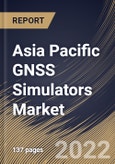Space Based Augmentation Systems (SBAS) are usually intended to increase the integrity and accuracy of the GPS /GNSS system for aircraft navigation and landing, in particular. SBAS satellites provide correction signals back to Earth, where SBAS corrections and integrity information are used to enhance accuracy and integrity by SBAS-enabled receivers. The transmission of corrective signals via ground-based equipment is an alternative to space-based augmentation.
Limited Area Augmentation Systems (LAAS) is an example of a system that enables a receiver to extract increased accuracy and integrity data in a local area, such as an airport where severe standards must be satisfied to land a commercial aircraft. GSS4150, Spirent's unique LAAS VHF data broadcast signal simulator, may be used to test LAAS. A portion of a satellite's transmission comprises its exact orbital data. Initially, the US Naval Observatory (USNO) regularly watched these satellites' exact orbits.
As a satellite's orbit varied, the USNO transmitted the satellite new information. Subsequent transmissions from a modernized satellite would provide its most current ephemeris. The systems of today are more straightforward. The satellite transmits a signal including orbital data and the precise time at which the signal was transmitted. Orbital data contain a broad almanac for locating all satellites and a precise ephemeris for this particular satellite.
The orbital ephemeris is delivered within a data message that is overlaid atop a timing reference code. The spacecraft employs an atomic clock to keep all satellites in the constellation synchronized. The receiver measures the time of flight to each satellite by comparing the time of broadcast included in the transmission of three distinct satellites.
It is anticipated that China's Beidou satellite navigation system would provide coverage by 2020, with location accuracies of fewer than ten meters (or one meter with regional augmentation) utilizing a network of 35 satellites. China has sought to field its satellite navigation system to address national security standards by closing military reliance on GPS, building a commercial downstream satellite navigation industry to capitalize on the rapidly expanding market; and achieving a domestic and international reputation by fielding one of only four navigation satellites.
The China market dominated the Asia Pacific GNSS Simulators Market by Country in 2021; thereby, achieving a market value of $26.0 million by 2028. The Japan market is registering a CAGR of 9.4% during (2022-2028). Additionally, The India market would showcase a CAGR of 10.8% during (2022-2028).
Based on Receiver, the market is segmented into GPS, Galileo, GLONASS, BeiDou, and Others. Based on Application, the market is segmented into Navigation & Mapping, Surveying, Location-based Services, Vehicle Assistance System, and Others. Based on Component, the market is segmented into Hardware, Software, and Services (Professional Services and Managed Services). Based on Vertical, the market is segmented into Military & Defense, Consumer Electronics, Automotive, Marine, Aerospace, and Others. Based on countries, the market is segmented into China, Japan, India, South Korea, Singapore, Malaysia, and Rest of Asia Pacific.
The market research report covers the analysis of key stake holders of the market. Key companies profiled in the report include Spirent Communications plc, Keysight Technologies, Inc., Viavi Solutions, Inc., Hexagon AB, U-blox Holding AG, Rohde & Schwarz GmbH & Co. KG, Syntony GNSS, RACELOGIC Ltd., Averna Technologies, Inc. and Accord Software & Systems Private Limited.
Scope of the Study
By Type
- Multi Channel
- Single Channel
By Receiver
- GPS
- Galileo
- GLONASS
- BeiDou
- Others
By Application
- Navigation & Mapping
- Surveying
- Location-based Services
- Vehicle Assistance System
- Others
By Component
- Hardware
- Software
- Services
- Professional Services
- Managed Services
By Vertical
- Military & Defense
- Consumer Electronics
- Automotive
- Marine
- Aerospace
- Others
By Country
- China
- Japan
- India
- South Korea
- Singapore
- Malaysia
- Rest of Asia Pacific
Key Market Players
List of Companies Profiled in the Report:
- Spirent Communications plc
- Keysight Technologies, Inc.
- Viavi Solutions, Inc.
- Hexagon AB
- U-blox Holding AG
- Rohde & Schwarz GmbH & Co. KG
- Syntony GNSS
- RACELOGIC Ltd.
- Averna Technologies, Inc.
- Accord Software & Systems Private Limited
Unique Offerings
- Exhaustive coverage
- The highest number of Market tables and figures
- Subscription-based model available
- Guaranteed best price
- Assured post sales research support with 10% customization free
Table of Contents
Companies Mentioned
- Spirent Communications plc
- Keysight Technologies, Inc.
- Viavi Solutions, Inc.
- Hexagon AB
- U-blox Holding AG
- Rohde & Schwarz GmbH & Co. KG
- Syntony GNSS
- RACELOGIC Ltd.
- Averna Technologies, Inc.
- Accord Software & Systems Private Limited








